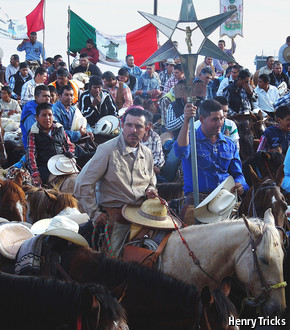
Sombreros off for church
BEFORE dawn on January 4th the mesquite trees around José Reyes Morin’s farm are lit up with Christmas lights. Inside the house, breakfast is eaten by candlelight. Mr Morin, a stickler for the old ways, doesn’t much believe in using electricity at home for anything other than religious occasions.
Appetites sated, a score of cowboys, one young woman and your (less young) correspondent mount scraggy horses. “Viva Cristo Rey,” (“Long Live Christ the King”) shouts Mr Morin, silver-buttoned comandante of the group, as the riders set off on a three-day pilgrimage to the 23-metre (75-foot) statue of Cristo Rey, high on a hill in the very centre of Mexico. That cry could once have got him killed as a Catholic reactionary. Today it is a call to rural traditions of faith and endurance in Mexico’s industrial heartland.
As the sun rises, the group grows. By lunchtime about 850 horsemen, and a handful of women, are heading towards the monument, visible many miles away. Priests whom they encounter remind them that they are riding in the hoofprints of the Cristero martyrs, who fought a guerrilla war against the anticlerical forces of President Plutarco Elías Calles in 1926-29. The first Cristo Rey statue was blown to bits by callistas in 1928. One old-timer, who did his first pilgrimage shortly after it started in 1956, recalls that when early pilgrims shouted “Viva Cristo Rey”, antagonists retorted: “Long Live the Supreme Court of Justice”.
Their route threads past a General Motors factory in a state where Mazda and Honda also have car plants and an urban middle class is emerging. The pilgrims, who are mostly farmers, have different values. After a hard day’s riding, they sleep rough, using saddles as pillows. They are forbidden even a drop of tequila.
Before bed, they line up for hours to confess, knees bent on the pavement, to a priest sitting on a chair under a streetlamp. At 5am, they get up for mass.
Moustached, tattooed, scarred and shaven-headed, some look as roguish as any bandido. Many have worked north of the border as illegal immigrants. The culture is hierarchical and macho: most will not let their wives ride with them. But they murmur prayers with cherubic devotion and life revolves around families and horses.
Along the route children run gleefully for sweets thrown by the horsemen, and entrust to them letters to the Three Kings, asking for presents on Epiphany. On that day, January 6th, some 3,000 saddle-sore riders eventually make it up the cobblestoned slope to the Cristo Rey, praying fervently. When your correspondent asks where to put the children’s letters, he is told he can throw them away. “It’s only make believe,” says one rider, with a cowboy’s bluntness.

No comments:
Post a Comment